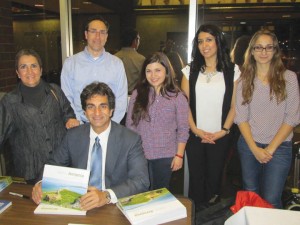Marine Vardanayn
Editor

Sometimes it takes an accident to produce the most beautiful of works. Attorney Matthew Karanian, author of the new illustrated book, Historic Armenia After 100 Years, admitted that the product itself was an “accidental publication.” Karanian spoke on the process of creating his book as part of the Spring Lecture series of the Armenian Studies Program, held on Tuesday, February 17, at Fresno State.
What started out as a visit to historic Western Armenia for a wedding in Cilicia, soon led to the production of a book that holds images of historic Armenia from 100 years ago to the present. Illustrated with 125 color photos and maps, Historic Armenia allows readers to travel through history and experience the Armenia that was once populated by Armenians. Karanian has travelled to and from historic Armenia since 1997, capturing images of Armenian landscapes, structures, and people.
Historic Armenia focuses on the six Western Armenian provinces along with the Eastern Armenian region of Ani and Kars. Like many with ties to Western Armenia, Karanian was ambivalent about travelling to the land of his ancestors. The region seemed to be haunted by the presence of the Armenian people and the Genocide of 1915. During the presentation, vibrant photos of Western Armenia lit up the auditorium, however, not all photos elicited positive feelings. One image showed a church with uneven terrain surrounding it, a remnant of efforts to dig up “Armenian gold” after the Genocide and a common scene in many of Karanian’s visits to historic Armenian sites.
Despite his initial hesitancy, Karanian’s first day in Western Armenia was a transformative experience when he participated in a Badarak (Divine Liturgy) at the Church of the Holy Cross with Archbishop Mesrob Ashjian and scholars Dr. James Russell and Armen Aroyan.
It was this experience on Akhtamar island that inspired Karanian to continue his travels, scratch the surface, and find more of the lost homeland. “Akhtamar is the bone sticking above the sand,” said Karanian.
Karanian compared 100-year-old photos of several churches, before and after, but he was not prepared for the shock of seeing the ruined structures, many of which were a direct result of Turkish government vandalism and military damage.
Ani, once known as the “City of 1001 Churches,” is one of the areas with a dense number of cultural sites.
Powerful photos of what remained of the city showed the frail condition of many churches and the remnants of the capital, depicted by a multitude of scattered rocks.
Karanian’s photos not only captured the surviving Armenian structures, but also the surviving Armenians. These hidden Armenians were encountered in Diyarbakir, Chunkush, and Zara.
A 95 year-old Armenian woman named Aida shared the story of her mother, who was taken by a Turkish soldier as a bride. Though Aida and her mother continued to live in Chunkush after the Turkish man died, their Armenian identities were never forgotten. She expressed her joy in encountering fellow Armenians, “I get as happy as a mountain.”
A particularly interesting point of the presentation revolved around Karanian’s visit to Kharpert, a city that was home to many Armenians who immigrated to Fresno. Due to the American missionary presence in Kharpert, more than 80 percent of Armenians in the United States prior to the Genocide were Kharpertsis.
Though Karanian photographed numerous breathtaking sites, even the most innocent looking views could not escape the memory of the Genocide, as many of them were the killing grounds for thousands of Armenians.
It is because of this painful fact that many Armenians face difficulty in visiting their ancestral homeland. For many, the presentation was the closest they will ever get to Western Armenia.
But were we wrong to stay away from our homeland for the past 100 years?
This question, asked by Karanian, may not have a simple answer. Yet for Karanian, one thing is certain, “If we keep staying away, there will be nothing left for us to see.”
Karanian dedicated his new book to his two grandmothers, both survivors of the Armenian Genocide, and to everyone who has helped rise and rebuild from the Genocide.
Information about the book Historic Armenia may be found at the following website: http://www.historicarmeniabook.com/.
 Hye Sharzhoom Armenian Action
Hye Sharzhoom Armenian Action